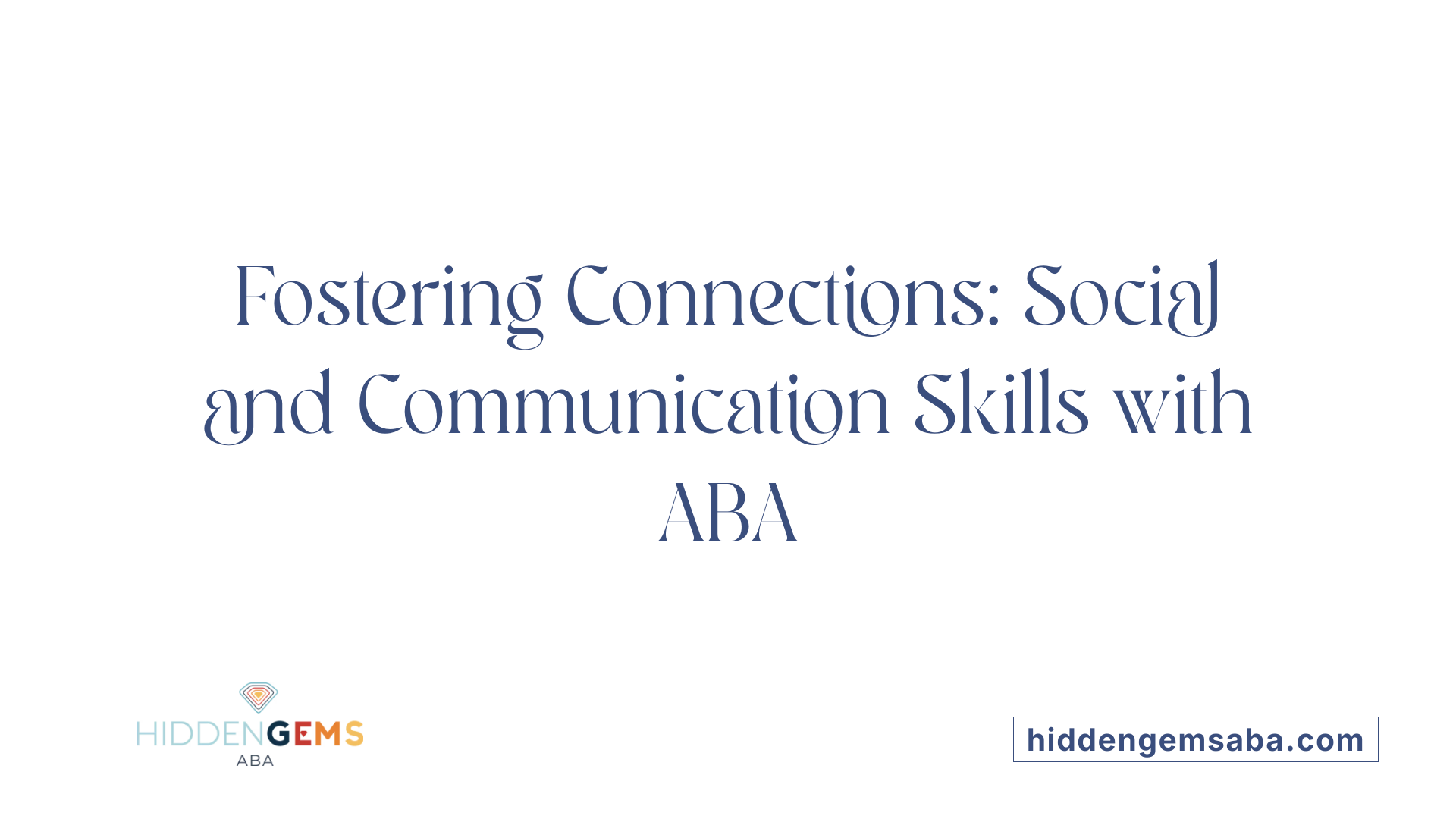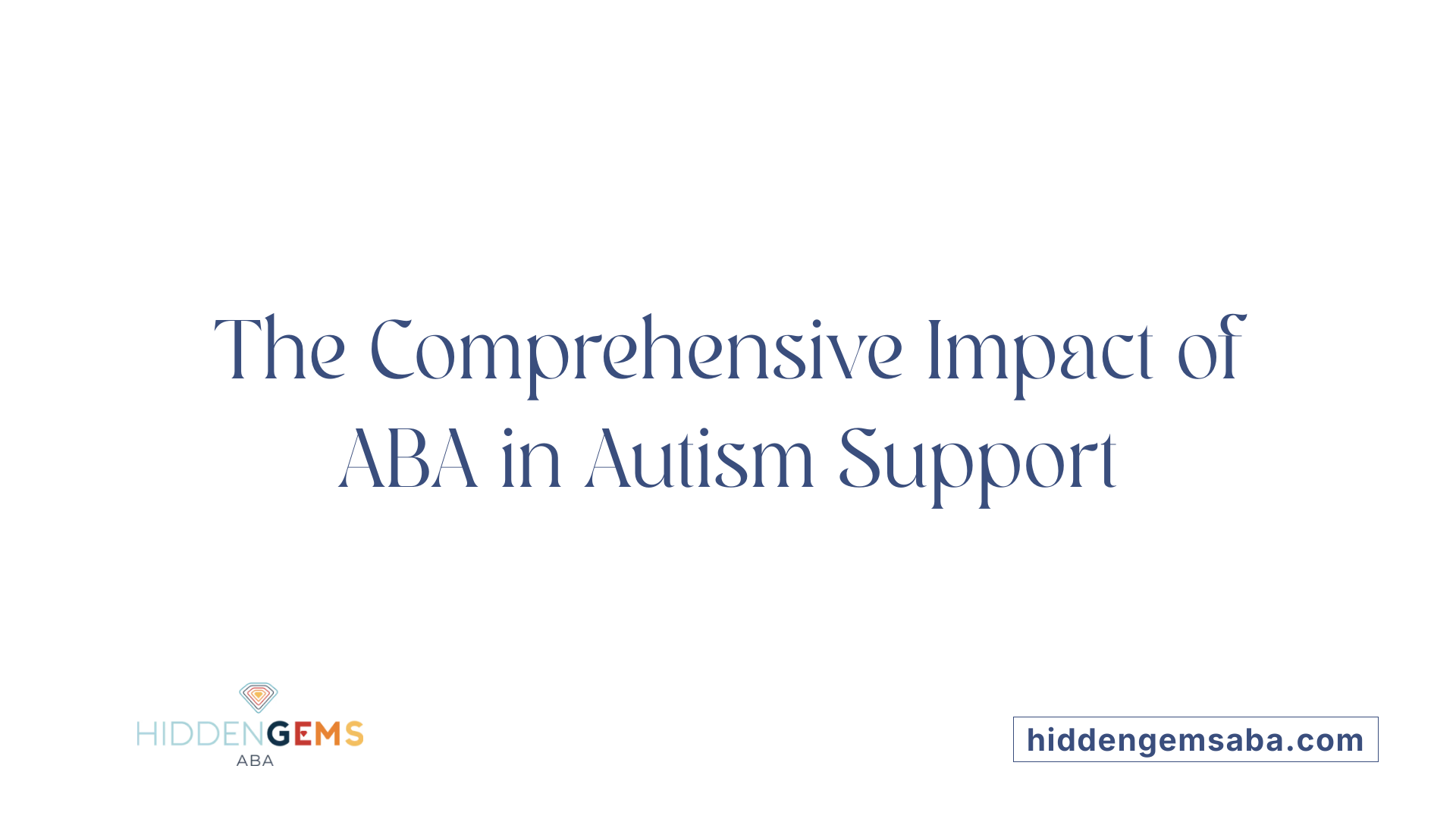Understanding ABA Therapy’s Role in Autism Skill Enhancement
Applied Behavior Analysis (ABA) has established itself as the gold standard in autism intervention, offering structured and individualized support that promotes meaningful skill development. This comprehensive approach supports children and adults with autism in acquiring social, communication, and daily living skills, fostering independence and improving overall quality of life. This article explores various ABA therapy programs, core principles, methods, and their impactful contributions to individual development.
Key Programs and Approaches in ABA Therapy for Autism
What are the common programs and approaches that utilize ABA therapy for autism?
Applied Behavior Analysis (ABA) offers several established programs and strategies that are tailored to meet the unique needs of children with autism. These approaches are designed to develop social, communication, and adaptive skills while reducing problematic behaviors.
Discrete Trial Training (DTT) is one of the most structured methods within ABA. It involves breaking skills down into small, manageable components and teaching them through repeated trials. Each trial involves clear prompts, responses, and reinforcement, providing children with consistent opportunities to learn and succeed.
Pivotal Response Training (PRT) adopts a more naturalistic approach. It emphasizes key skills such as motivation, self-management, and social initiations that have a broad impact on other areas of development. PRT encourages child-led learning through play and real-life interactions, making it engaging and adaptable.
Early Start Denver Model (ESDM) is a developmental intervention designed specifically for young children with autism. It combines ABA principles with developmental models, fostering improvements in social, communication, and play skills from an early age. ESDM is typically delivered through naturalistic, play-based activities, emphasizing positive engagement with caregivers.
Natural Environment Teaching (NET) focuses on teaching skills in everyday contexts. This approach aims to promote functional use of skills by embedding learning opportunities into natural routines and settings such as home, school, or community environments. It emphasizes spontaneous teaching moments and child interests.
Each of these programs shares core principles involving positive reinforcement, individualization, and family involvement. They are overseen by licensed behavior analysts, including Board Certified Behavior Analysts (BCBAs) who design and supervise interventions.
| Program/Approach | Description | Key Features | Typical Settings |
|---|---|---|---|
| Discrete Trial Training | Repetitive, structured teaching with clear prompts and reinforcement | Repetition, consistency, small steps | Clinic, home, school |
| Pivotal Response Training | Naturalistic, child-led learning focusing on pivotal skills | Motivation-based, play-oriented, flexible | Home, community, therapy sessions |
| Early Start Denver Model | Developmental, play-based early intervention | Early start, comprehensive, play-based | Home, early intervention programs |
| Natural Environment Teaching | Learning in natural routines and settings | Spontaneous teaching, functional skills, child interests | Home, school, community |
How do these approaches support children with autism?
All these programs are tailored to the child's interests and developmental level. They aim to build communication and social skills, support emotional regulation, enhance cognitive development, and foster independence in daily activities. The integration of naturalistic and structured strategies ensures that learning is engaging, relevant, and sustainable.
Who delivers these programs?
Highly trained professionals, including BCBAs and RBTs, supervise these interventions. They continually assess progress and adjust strategies to maximize effectiveness. Family involvement is also emphasized to reinforce skills across various settings.
| Program/Approach | Target Skills | Main Goals | Delivery Method |
|---|---|---|---|
| Discrete Trial Training | Language, academic, daily living skills | Skill acquisition, behavior reduction | Individual sessions, structured |
| Pivotal Response Training | Motivation, social initiations, self-management | Broad developmental improvements | Child-led play, natural settings |
| Early Start Denver Model | Social engagement, communication, play | Early developmental gains | Play-based, parent-inclusive |
| Natural Environment Teaching | Functional daily skills | Generalization, independence | Natural routines, spontaneous teaching |
These approaches demonstrate the versatility and effectiveness of ABA in supporting children with autism across different settings and developmental stages.
Core Principles and Strategies of ABA Therapy

What are the core principles and strategies of ABA therapy for autism skill development?
Applied Behavior Analysis (ABA) therapy is a highly researched, evidence-based method recognized globally as an effective approach for supporting children with autism. This therapy revolves around understanding the reasons behind certain behaviors, which are often tied to one of four functions: gaining attention, escaping from demands, accessing tangible items, or automatic reinforcement that provides sensory satisfaction.
By identifying these functions, therapists can tailor interventions that modify behaviors in meaningful ways. Central to ABA are positive reinforcement strategies, where desired behaviors are rewarded to increase their occurrence. For instance, when a child attempts to communicate or interact socially, they might receive praise, a small tangible reward, or preferred activities, encouraging them to repeat these behaviors.
ABA therapy employs breaking down complex skills—such as communicating needs, social interactions, or self-care routines—into small, manageable steps. This sequential teaching helps children learn skills systematically, building confidence and competence over time.
Assessment plays a crucial role in ABA, with data collection informing every step of intervention. This ongoing assessment allows therapists to adjust strategies to the child’s evolving needs, ensuring each program remains personalized and effective.
The interventions encompass various teaching methods, including Discrete Trial Training (DTT), which involves structured, repetitive teaching, and naturalistic teaching, such as Naturalistic Developmental Behavioral Interventions (NDBI). These methods foster skill acquisition within natural environments, making skills more functional and applicable to real life.
Focus areas within ABA include communication, social interaction, emotional regulation, daily living skills, and cognitive development. For example, children might be taught to initiate conversations, share interests, or complete daily routines independently.
The overall goal of ABA is to bring about meaningful, functional improvements that enhance the child’s ability to navigate their environment, communicate effectively, and participate actively in daily life. This is achieved through a systematic application of learning principles, active caregiver involvement, and continuous progress monitoring.
In summary, ABA therapy’s core strategies—understanding behavior functions, reinforcing positive behaviors, breaking down skills, and using data-driven approaches—combine to create a flexible, effective approach for supporting children with autism in developing vital skills for social, communicative, and daily functioning.
Methods and Best Practices in ABA for Skill Support

What methods and best practices are used in ABA therapy to support skill development in individuals with autism?
Applied Behavior Analysis (ABA) employs a set of proven methods designed to help children and adults with autism develop essential skills in communication, social interaction, and daily living. These methods are grounded in scientific research and are tailored to each individual’s unique needs.
One foundational technique in ABA is task analysis, which involves breaking down complex skills into smaller, manageable steps. This approach makes learning more accessible and allows therapists to target specific components of a skill, gradually building toward mastery.
Reinforcement strategies are central to ABA. Positive reinforcement encourages desired behaviors by providing rewards or praise, increasing the likelihood that the behavior will be repeated. Conversely, although less common, negative reinforcement can also be used to reduce undesired behaviors.
Another important practice is prompting and prompt fading. Prompting involves giving cues or hints to help the individual perform a skill correctly. Over time, prompts are gradually reduced or faded out to foster independent performance.
Modeling involves demonstrating desired behaviors for the individual to imitate. This method is effective in teaching social and communication skills, especially when combined with reinforcement.
Behavior chaining is used to teach sequences of behaviors, like brushing teeth or tying shoes. It links individual steps into a complete chain, with prompts and reinforcement guiding the learner through each stage.
In addition to these techniques, ABA integrates the use of visual supports such as schedules, social stories, and pictorial prompts. These tools help improve communication, understanding of routines, and social skills.
Naturalistic teaching approaches like Naturalistic Developmental Behavioral Intervention (NDBI) and Pivotal Response Treatment (PRT) focus on child-led, play-based learning in natural environments. These strategies promote skill generalization and make learning more engaging.
Therapists regularly collect data on behavior and skill acquisition, enabling ongoing progress monitoring. This data-driven approach ensures interventions remain effective and are adjusted as needed.
Family involvement and collaboration are emphasized to reinforce learning across settings, ensuring consistency and maximizing development.
In summary, ABA's array of methods—task analysis, reinforcement, prompting, modeling, chaining, visual supports, and naturalistic techniques—are all supported by ongoing assessment and are adapted to each person’s progress, making ABA a comprehensive and effective approach to skill development in autism.
Below is a summary table of methods and strategies used in ABA therapy:
| Method/Strategy | Purpose/Use | Additional Details |
|---|---|---|
| Task Analysis | Breaks down skills into steps | Facilitates step-by-step learning |
| Reinforcement Strategies | Encourages desired behaviors | Includes positive and negative reinforcement |
| Prompting & Fading | Supports correct responses and promotes independence | Gradually reduces prompts over time |
| Modeling | Demonstrates behaviors for imitation | Used for social and communication skills |
| Behavior Chaining | Teaches sequences of actions | Links individual steps into a complete skill |
| Visual Supports | Enhances understanding and communication | Schedules, social stories, pictorial cues |
| Naturalistic Teaching | Promotes generalization through child-led activities | Integrates play and real-world context |
| Data Collection & Monitoring | Tracks progress and guides therapy adjustments | Ensures individualized approach |
| Family Involvement | Reinforces skills beyond therapy sessions | Critical for consistent learning |
By combining these practices, ABA therapy creates a flexible, effective, and supportive environment for individuals with autism to develop critical skills, confidence, and independence.
Supporting Social Skills and Communication Development

How can ABA therapy improve social skills in children with autism?
ABA (Applied Behavior Analysis) therapy is a highly effective approach for enhancing social skills in children with autism. It offers structured, personalized interventions designed to teach children essential social behaviors, such as initiating conversations, sharing, taking turns, and making eye contact.
To facilitate these skills, ABA therapy employs various techniques like modeling and role-playing. For example, therapists might model a social gesture or phrase, then guide the child through role-playing scenarios where they can practice the behavior in a safe environment. Social stories are also utilized, which are simple, illustrated narratives that teach children appropriate responses to various social situations, helping them understand social cues and expectations.
Natural environment training is a cornerstone of ABA, where learning occurs in natural settings like playgrounds or homes, making social skills more relevant and easily generalizable to real-life situations. This approach encourages children to apply what they learn during therapy to their everyday interactions.
Reinforcement strategies are crucial in ABA. When a child successfully demonstrates a social skill, they receive positive reinforcement, such as praise or a preferred activity. This motivates repeated use of the behavior, leading to stronger and more consistent social skills over time.
By tailoring interventions to each child's unique needs and challenges, ABA therapy helps children better interpret social cues, understand others’ intentions, and respond appropriately. This results in improved communication, stronger social connections, and increased confidence in social settings.
Organizations like 'Autism From The Start' emphasize compassionate, child-centered ABA approaches. Their team of trained professionals integrates these techniques into playful, naturalistic activities that foster genuine social development.
In addition to traditional face-to-face interventions, digital tools and structured programs like PEERS for young adults further support social skills growth. Community participation also plays an important role in promoting social inclusion, helping individuals build meaningful relationships outside structured therapy sessions.
Below is a summary of the different methods and their roles in improving social skills in children with autism:
| Method | Description | Benefits |
|---|---|---|
| Modeling and Role-Playing | Demonstrate expected behaviors; practice in simulated scenarios | Builds confidence; ensures understanding and application |
| Social Stories | Narrative-based teaching about social situations | Clarifies expectations; reduces anxiety |
| Natural Environment Training | Learning in real-life settings like home or playground | Promotes generalization; makes skills relevant |
| Reinforcement Techniques | Reward for demonstrating desired behaviors | Motivates learning; encourages repetition |
Overall, ABA therapy’s evidence-based methods foster meaningful gains in social and communication skills, supporting children with autism to engage more fully with their peers and community.
Impact of ABA on Overall Developmental Outcomes

How does ABA therapy contribute to overall developmental outcomes for individuals with autism?
ABA therapy plays a significant role in enhancing the developmental trajectory for individuals with autism. It focuses on teaching vital skills like communication, social interaction, and daily living activities tailored to each child's unique needs. Using scientifically supported methods such as reinforcement strategies, discrete trial training, and natural environment teaching, ABA promotes positive behaviors and diminishes problematic ones.
One of the notable benefits of ABA is its effectiveness when interventions are implemented early and with intensity. Early ABA intervention has consistently shown improvements in cognitive abilities, language development, and social skills, setting a strong foundation for future growth. The individualized nature of ABA allows therapists to adapt strategies across various settings—home, school, or community—helping children generalize their skills beyond therapy sessions.
Furthermore, ABA therapy supports the long-term development of meaningful skills that contribute to increased independence. Skills learned through ABA can include self-care routines, problem-solving, and emotional regulation. As children grow, these skills translate into better participation in social activities and community life.
How does ABA therapy improve communication, social interaction, and daily living skills?
Communication is often a core focus of ABA, with many programs aiming to develop both receptive and expressive language. Techniques such as shaping and modeling help children improve their ability to express their needs and understand others. Social skills are also emphasized through play-based and naturalistic interventions, promoting interactions with peers and adults.
Daily living skills—such as dressing, grooming, and simple household tasks—are integrated into ABA programs to foster independence. Skill-building is supported by the use of reinforcement, which motivates children to practice and solidify these essential routines.
How does early intervention enhance lifelong outcomes?
The emphasis on early and intensive ABA therapy is backed by research indicating that initiating treatment during early developmental stages yields the best long-term results. Early intervention takes advantage of the brain's plasticity, facilitating faster and more robust skill acquisition. In many cases, early ABA therapy has led to significant improvements in language, social engagement, and cognitive flexibility.
Can ABA therapy ensure skills are transferred across different environments?
Yes, ABA techniques are designed to promote generalization, meaning skills learned during therapy can be applied in various contexts. Through naturalistic teaching approaches, children practice skills in real-life settings, boosting their ability to use these skills spontaneously and appropriately outside of structured sessions.
What is the impact of ABA on long-term development?
Research indicates that consistent ABA intervention supports sustained progress. Many individuals continue to develop new skills and enhance existing ones well into adolescence and adulthood. The focus on foundational skills—communication, socialization, and independence—ultimately improves overall quality of life, enabling individuals with autism to participate more fully in everyday activities and social roles.
| Aspect | Description | Additional Details |
|---|---|---|
| Communication | Development of expressive and receptive language | Uses reinforcement, shaping, modeling |
| Social Interaction | Engagement with peers and adults | Play-based, peer models, social stories |
| Daily Living | Self-care, household tasks | Task analysis, step-by-step training |
| Early Intervention | Initiation during critical developmental periods | Leads to better outcomes, higher adaptability |
| Generalization | Skills transfer across settings | Naturalistic teaching, real-world practice |
| Long-term Progress | Sustained skill development | Enhances independence, community participation |
The Broader Significance of ABA in Autism Interventions

Personalized, family-centered approaches
Applied Behavior Analysis (ABA) therapy stands out for its tailored approach to each child's unique needs. Recognizing that every child with autism exhibits different behaviors, skills, and interests, ABA professionals design individualized programs focusing on specific developmental goals. This personalized nature ensures that interventions are both effective and meaningful, fostering growth in social, communication, and daily living skills.
An essential aspect of ABA is its emphasis on family involvement. Families are considered integral to the therapy process, receiving guidance and training to support their child's development at home and in natural settings. This family-centered approach helps reinforce skills learned during therapy sessions, making progress sustainable and aligned with the child's everyday life.
Role of trained professionals
The success of ABA therapy relies heavily on the expertise of trained professionals such as Board Certified Behavior Analysts (BCBAs) and Registered Behavior Technicians (RBTs). These specialists possess specialized training in behavioral principles and child development, enabling them to implement and adapt interventions effectively.
BCBAs, in particular, oversee the therapy process, develop personalized treatment plans, and regularly assess progress. RBTs assist in delivering therapy under the supervision of BCBAs, ensuring consistency and fidelity to the intervention model.
This team-based structure underscores the importance of ethical, evidence-based practices and continuous professional development. Their expertise ensures that interventions remain compassionate, culturally sensitive, and tailored to each child's evolving needs.
Technological advancements in ABA
Recent advancements have introduced innovative digital platforms and tools that complement traditional ABA interventions. Behavioral Intervention Technologies (BITs) provide accessible, cost-effective means for social skills training, especially valuable during situations that limit in-person interactions.
For example, digital programs can simulate social scenarios, offer real-time feedback, and reduce anxiety associated with face-to-face interactions. These technologies expand opportunities for children to practice social skills in controlled, engaging environments.
Moreover, programs like PEERS demonstrate the effectiveness of structured, technology-assisted social skills training, especially for young adults. They have shown improvements in social engagement, electronic communication, and peer relationships.
Community engagement also plays a vital role. Incorporating community programs enhances social inclusion and provides meaningful contexts for applying learned skills, leading to a more comprehensive approach to supporting individuals with autism.
| Aspect | Description | Additional Details |
|---|---|---|
| Program Personalization | Tailoring interventions to child’s needs | Focuses on interests, behaviors, and developmental goals |
| Family Involvement | Engaging family in therapy | Training and support for in-home practice |
| Professional Expertise | Trained analysts and technicians | Oversight, customization, and ethical practice |
| Technology Integration | Digital tools and platforms | Virtual social skills practice, accessibility, and engagement |
| Community Engagement | Participation in social activities | Fosters real-world socialization and inclusion |
In sum, ABA therapy's evolution reflects a holistic approach that combines personalized strategies, expert professionals, and technological innovations. These elements work together to improve social skills, independence, and overall quality of life for children and adults with autism, emphasizing that effective support adapts to the individual's environment, preferences, and developmental stage.
Empowering Growth and Independence
ABA therapy, with its evidence-based strategies and personalized frameworks, plays a pivotal role in transforming the lives of individuals with autism. By targeting core developmental areas such as communication, social skills, and daily living abilities, ABA programs foster greater independence and social inclusion. The integration of innovative approaches and active family participation ensures that intervention remains effective and responsive to each individual’s unique needs. Continued advancements in ABA methodologies promise even greater success in supporting lifelong growth and fulfillment for those on the autism spectrum.
References
- Best Social Skills Training Methods for Autism
- ABA Certified
- Social Skills Training for Adults on the Autism Spectrum
- Applied Behavior Analysis (ABA)
- Social Skills Training in Applied Behavior Analysis? ASD
- The effectiveness of applied behavior analysis program ...
- Enhancing Social Skills Through ABA Therapy
- How ABA Therapy Improves Social Skills in Children With ...
- Applied Behavior Analysis (ABA)






